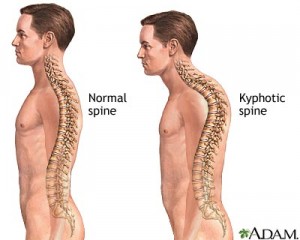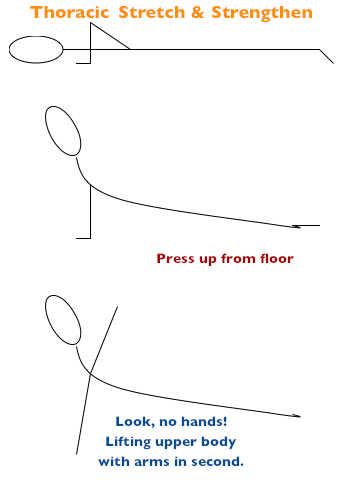 The middle of your back is a section of the vertebral column called the thoracic spine.
The middle of your back is a section of the vertebral column called the thoracic spine.
Structure:
The vertebrae of the thoracic spine are labeled T1-T12 and make up the middle section of the spinal column. Much like their counterparts in the Cervical spine, each vertebra consists of a round, flat body and hollow vertebral foramen (where the spinal cord passes), surrounded by a spinous process and two transverse processes. The transverse processes of the thoracic spine articulate with the ribs, completing the thoracic cage that surrounds the lungs and heart. The curve is convex, forming the arch of the upper back that is referred to as kyphosis.

More on kyphosis:

This term can also be used to describe a pathological condition in which the thoracic curve is overly pronounced. A person with this condition will appear to have a “hunchback”. While it is much more common to see this in older people, kyphosis can develop in youth and young adults as a result of excessive slouching.
It is much more likely to be corrected in young people, and there is a bit of research that suggests that dance training can restore an average curve of the thoracic spine (Alricsson & Warner, 2004). This is perhaps on account of the “dancer’s stance” and continual lengthening of the spine that is characteristic of dance training.
Function:
Of all the spinal sections, the thoracic vertebrae are least capable of movement, however it is exceedingly important to the movements of dance. Flexion and extension are possible, although most individuals have limited flexibility in this regard. Here’s another instance in which the natural selection of dancers and the inherent nature of our training yields a higher degree of flexibility (Nilsson et. al, 1993).
The thoracic spine is also responsible for lateral movements (side-to-side) and twisting. These, again, are movements that are reliant on the degree of flexibility in the dancer. To really get an idea of your movement capability in the thoracic spine, get out your white jazz oxfords and perform some rib isolations. There are a lot of muscles at work here, including the groups of intertransverse, interspinalis, and transversospinalis muscles, as well as iliocostalis thoracis and longissimus thoracis, all of which assist in side bending, rotation, and extension of the upper back. Think arabesques, combrés, and épaulment – movements that are possible with this complex system of small muscles, and are supported by the large, fan-like latissimus dorsi and the upper abdominals.
 Stretch and strengthen:
Stretch and strengthen:
Try this exercise to increase the flexibility and strength of your thoracic spine:
- Lay on your stomach with your hands under your shoulders
- Push up on to your hands, lifting your chest off the ground (note: be sure to protect your lower back by lifting the abdominals and avoiding overextension)
- Repeat three times, holding for about 60 seconds, then on the third time try and lift the upper body without your hands on the ground.
- Try different arm positions: second, fifth en haut, “winged” behind you, hands behind head, etc. Some are more challenging than others.
Stay turned for part 3 of The Stem of Aplomb, where we will talk about the lumbar spine, intervertebral discs, and injuries to the tailbone.
—
References:
- Alricsson, M. & Werner, S. (2004). The effect of pre-season dance training on physical indices and back pain in elite cross-country skiers: a prospective controlled intervention study. Br J Sports Med 38, 148-153.
- Calais-Germain, B. (1993). Anatomy of Movement. Seattle: Eastland Press.
-
Grieg, V. (1994). Inside Ballet Technique: Separating Anatomical Fact from Fiction in the Ballet Class
. Hightstown, NJ: Princeton Book Company.
-
Marieb, E.N. (2003). Human Anatomy and Physiology, sixth edition. Benjamin Cummings. (8th Edition found here)
-
Nilsson, C., Wykman, A. & Leanderson, J. (1993). Spinal sagittal mobility and joint laxity in young ballet dancers: a comparative study between first-year students at the Swedish Ballet School and a control group. Knee Surg Sports Traumatol Arthrosc 1, 206-208.
Lauren Warnecke is a freelance writer and editor, focused on dance and cultural criticism in Chicago and across the Midwest. Lauren is the dance critic for the Chicago Tribune, editor of See Chicago Dance, and founder/editor of Art Intercepts, with bylines in Chicago Magazine, Milwaukee Magazine, St. Louis Magazine and Dance Media publications, among others. Holding degrees in dance and kinesiology, Lauren is an instructor of dance and exercise science at Loyola University Chicago. Read Lauren’s posts.

